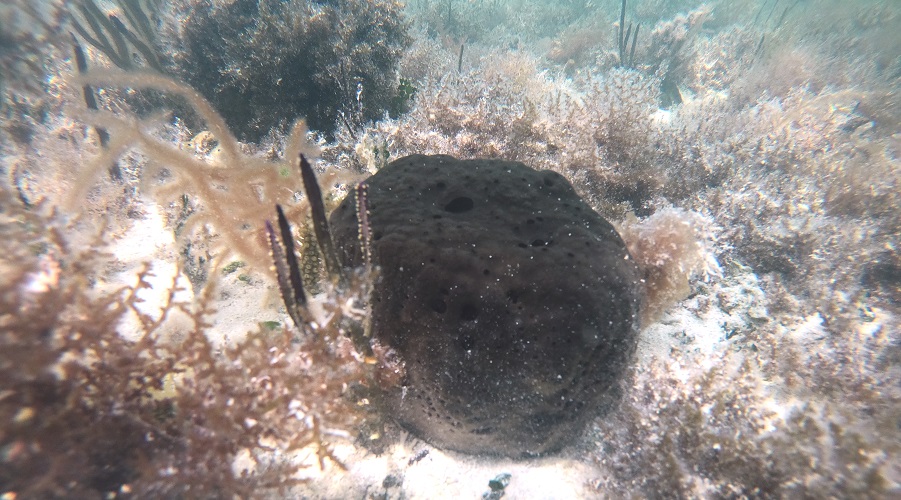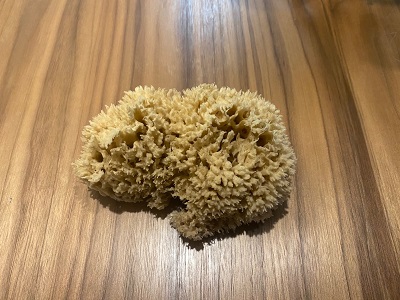
The inconspicuous sea sponges are Earth’s oldest multicellular animals and have filtered the oceans for nearly 900 million years, long before the first plants appeared on land. New research appearing in the journal Fisheries Bulletin, published by the National Oceanic and Atmospheric Administration, indicates that their growth depends on their oxygen supply in a manner similar to more complex animals such as fish.
Researchers from the University of British Columbia and Florida International University explain that a ‘dimensional tension’ is at play as sponges grow because they are forced to rely on the two-dimensional cross-section of their inhalant pores to supply their three-dimensional growing bodies with oxygen dissolved in water.
By analyzing data from new and previous studies on sponges, and estimating their growth parameters, the researchers suggest that such respiratory stress in the central portion of spherical sponges, such as those that are commercially harvested, limits their maximum size. The central, oxygen-poor part of near-spherical sponges is, however, rich in anaerobic microbes – those that do not require molecular oxygen to survive.

“This means that sponges have evolved in a way that allows them to nurture complex microbial communities within themselves to deal with the geometric constraints imposed on their physiology,” said Dr. Daniel Pauly, lead author of the study and principal investigator of the Sea Around Us initiative at UBC’s Institute for the Oceans and Fisheries.
“These microbial communities are similar to the human gut microbiome and can be equivalent to 40% of the sponge wet body weight. High densities of microbes confer multiple beneficial functions for the sponge, such as metabolic regulation,” Dr. Pauly said.
The UBC researcher is the person behind the Gill Oxygen Limitation Theory, which explains the links between growth and respiration in fish and other water-breathing animals.
“Sponges
originated over 800 million years ago in the Pre-Cambrian. At that time,
atmospheric oxygen levels were only about 50 per cent of what they are today. Although
global oxygen stores later increased with the evolution of multicellular
plants, for 500 million years sponges evolved in a world depauperate of oxygen.
In the absence of tissues or organs specialized for oxygen acquisition, sponge
morphology was likely strongly constrained by physiological oxygen demand,” said
Dr. Mark Butler, of Florida International University, a co-author of the study.
Understanding
the growth and evolution of these ancient organisms is important because they
serve important ecological functions in marine ecosystems, including in coral
reefs. Sponges are responsible for regulating the exchange of energy, mass, and
nutrients between habitats through filtration and nutrient cycling;
enhancing habitat complexity; altering sediment structures; contributing to
underwater soundscapes and providing food for spongivorous species.
“Sponges are
also important to fisheries,” said Dr. Nicola Smith, another co-author of the
study and a researcher at UBC’s Institute for the Oceans and Fisheries. “In the
Caribbean, the export of marine sponges began in the mid-1800s as they were
used for personal hygiene, house and car cleaning, medical surgery, glazing
pottery, and cleaning industrial machinery, among other uses. Today, international
demand for commercially harvested sponges is driven primarily by the cosmetic,
biomedical and aquarium trades.”
Data from the
Food and Agriculture Organization of the United Nations show that nearly 40,000
tonnes of processed sponges were exported by two dozen countries from 1950 to
2019, corresponding to 1 million tonnes in live weight.
“When it comes
to the number of countries exploiting sponge populations and their catches, the
FAO numbers are likely underestimates,” Dr. Smith said. “Also, the effects of commercial
fisheries on sponge communities are largely unknown, although in south Florida,
management limitation of harvest to the use of artisanal techniques appears to have
produced a sustainable fishery. In the past, however, many sponge fisheries
have been so overexploited that they collapsed.”
Following this study, the researchers will join forces with other colleagues to perform a detailed reconstruction of the catches of commercial sponges around the world. The paper “Growth and related traits of the wool sponge Hippospongia lachne: practical and theoretical considerations,” was published in Fisheries Bulletin DOI: 10.7755/FB.120.2.1

